Frugivores are animals that eat all or mostly fruit. This can include fruit, nuts, seeds, and even roots. Some will eat the fruit in addition to other parts of plants. These animals are a subcategory of herbivores, which refers to animals that eat only plants. Carnivores on the other hand eat only meat, while omnivores eat a combination of both plants and meat. Frugivores appear across the entire animal kingdom, including mammals, reptiles, and birds. While this list isn’t exhaustive, it is a good collection of some well-known frugivores as well as some animals you may be surprised to see.
#1 African Bush Elephant
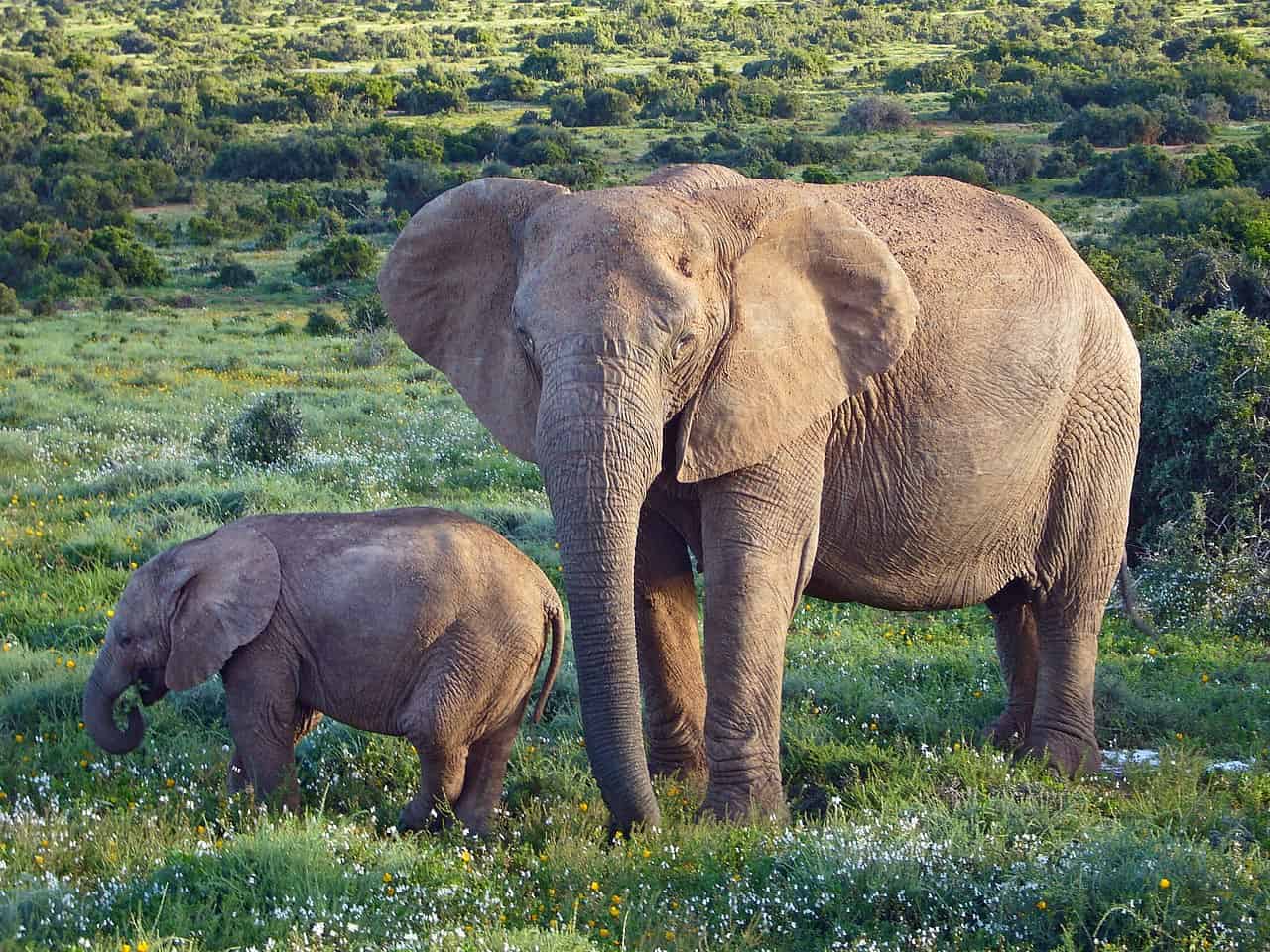
African Elephants use their long trunks to get food and water, such as this pair in Addo National Park, South
Africa
.
©Gorgo, Public domain, via Wikimedia Commons – License
You might be surprised to learn that the largest living land animal is actually an herbivore. African Bush Elephants can get up to 6 tons and they do so on an entirely plant-based diet. Just their tusks can weigh as much as 100 pounds. These animals eat a lot of bark, leaves, and branches. They also eat fruit and grass. They have to drink a lot to stay hydrated in the hot savanna. Sometimes, adult African elephants will drink as much as 50 gallons of water in one day.
African Bush Elephants have to constantly roam around to find enough food. They live in family units called herds, which helps them survive against the many predators on the African savanna. Fortunately for the elephants, their formidable size and tusks make them hard to take down, even for skilled hunters like lions and leopards.
#2 Mourning Dove

Mourning doves forage for food.
©Brooke Bowdren/Shutterstock.com
These doves are interesting among other similar birds because they don’t eat insects or bugs. Instead, they prefer seeds and fruit. They live in parts of Central and North America. Mourning doves are known for living in pairs as well as for their howling coos, which can be confused for hoots. Because they sound so sorrowful, they are called mourning doves.
They tend to prefer seeds over just about anything else. Mourning doves like sunflower seeds and cracked corn. You can even feed them peanuts and millet if you want to attract mourning doves. In addition to seeds, these doves will feast on parts of grasses, such as wheat, rye, canary grass, or foxtails.
#3 Spix’s Macaw
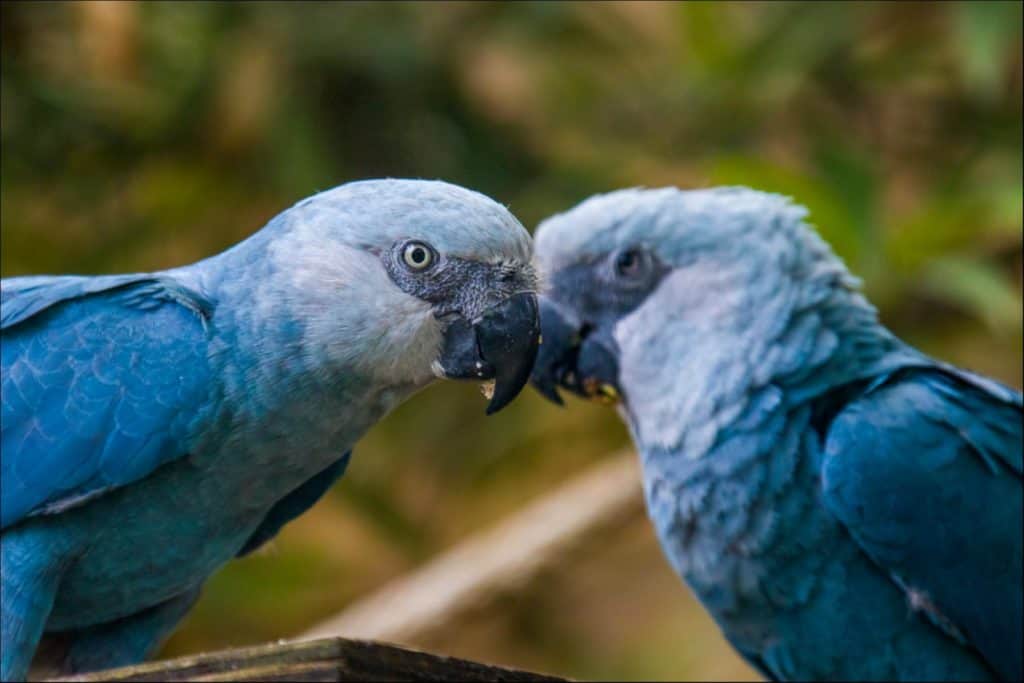
Spix’s macaws have blue feathers that make them stand out, even from other brightly colored macaws.
©Danny Ye/Shutterstock.com
Like other macaws, Spix’s Macaws eat fruit and seeds. These spectacular birds are completely blue and incredibly rare. Almost all Spix’s Macaws live in captivity and efforts focus on increasing the population after many years of habitat loss resulted in dwindled numbers. These birds eat a rich diet of seeds, fruit, and nuts. They also need supplements to keep themselves healthy.
Spix’s macaws make a wide range of sounds, including those that mimic human speech. This is one reason why macaws are popular birds to have as pets. It’s important to do your research before adopting a macaw, however, to make sure that you are only supporting places that bring in these birds responsibly. The illegal bird trade is very detrimental for the conservation of birds like Spix’s macaws. Because they are so rare, it is illegal to own a Spix’s macaw other than as part of conservation efforts.
#4 Spider Monkey

Spider monkeys look like spiders when they use their long tails to hang from trees.
©Nick Fox/Shutterstock.com
Many primates are omnivores, including some species of monkeys. Spider monkeys do eat both plants and animals, although they tend to prefer plants, especially fruit. Their diets are at least half fleshy fruits, such as passion fruit, when they can find them. If these aren’t available or if they eat their fill, they will eat leaves, flowers, eggs, insects, and other foods in their native habitat. They generally prefer fruit, however, even if other things are available. They do eat spiders, but their name comes from their spider-like appearance when they are hanging from trees and not from their dietary preferences.
#5 Black Rhinoceros
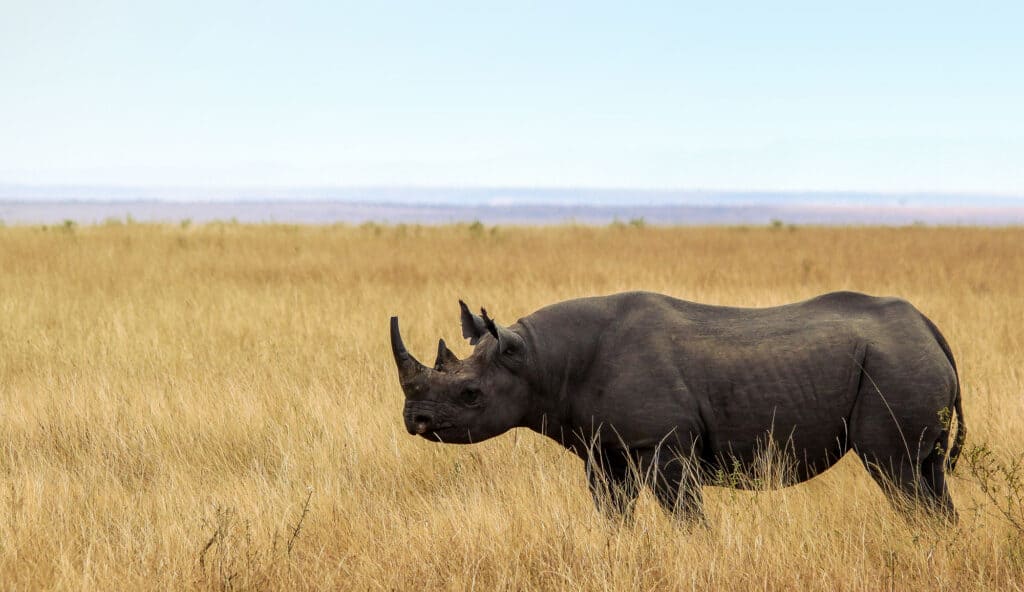
The majority of black rhinoceroses in the wild live in protected natural areas in Africa.
©iStock.com/Black Rhinoceros, Rhinoceros, Savannah, Tanzania, Animal
These rare rhinos are critically endangered and there are only around 3,000 left in the wild. They have been hunted for their horns for many years, although recent conservation efforts have helped to reduce this. In the wild, black rhinos eat fruit, grass, leaves, flowers, and roots. They use their horns to dig up roots and the buried parts of plants to eat. All rhinos have a similar diet. Even though they are herbivores, these animals grow to a very large size. Adult black rhinos can reach up to 3,000 pounds!
While they themselves are not predators, black rhinos are still large and in charge in their native environment. The only predators that can take on a black rhino are lions, leopards, hyenas, wild dogs, and crocodiles. Even these fearsome animals only take on young or vulnerable rhinos and aren’t a match for a healthy adult rhino. Human poachers are the biggest threat to adult rhinos in the wild.
#6 Baltimore Oriole

Unlike other birds, orioles prefer fruit and insects instead of seeds.
©Danita Delimont/Shutterstock.com
These colorful birds are native to North America and easy to distinguish thanks to their orange and black feathers. While they can live all around North America, they are very common on the East Coast and are the state bird of Maryland. They eat a lot of fruit, especially apples, oranges, and berries. They also enjoy peaches and bananas. In addition to fruit, Orioles eat nectar from flowers and some insects. They eat some moths, caterpillars, beetles, mealworms, and even wasps. Orioles are unique among birds because they do not eat seeds. If you want to attract Orioles to your yard, you’ll have more luck putting out fruit rather than traditional birdseed.
#7 Bornean Orangutan
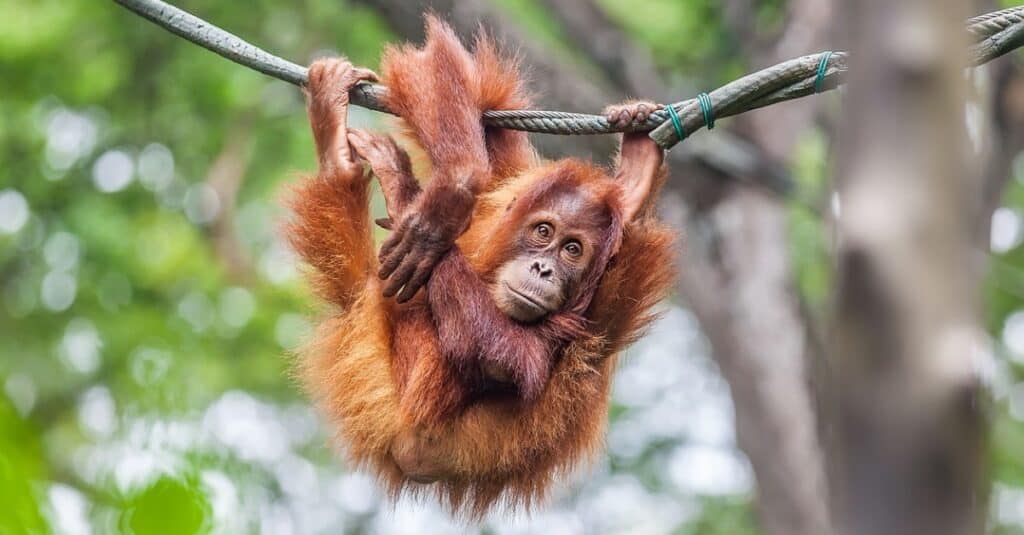
Orangutans spend the majority of their lives in the trees.
©iStock.com/molishka1988
Even though orangutans are omnivores, around 60% of their diet comes from fruit. There are three species of orangutan: Bornean, Sumatran, and Tapanuli. They all have similar diets, although they differ slightly in appearance and behavior as well as where they live. All orangutans live in southeast Asia and eat lychee, mangoes, and other native fruits. These primates also eat leaves and shoots as well as some insects. They get water from the fruit that they eat as well as water that they can find collected in trees.
All great apes other than orangutans are found in Africa. Orangutans, on the other hand, only live in Asia. They spend most of their lives hanging from and swinging in trees. They do come to the ground occasionally to either forage for more food or to move to a different area. Orangutans are much safer from tigers, their main predator, when they are high up in trees, however.
#8 Guinea Pig
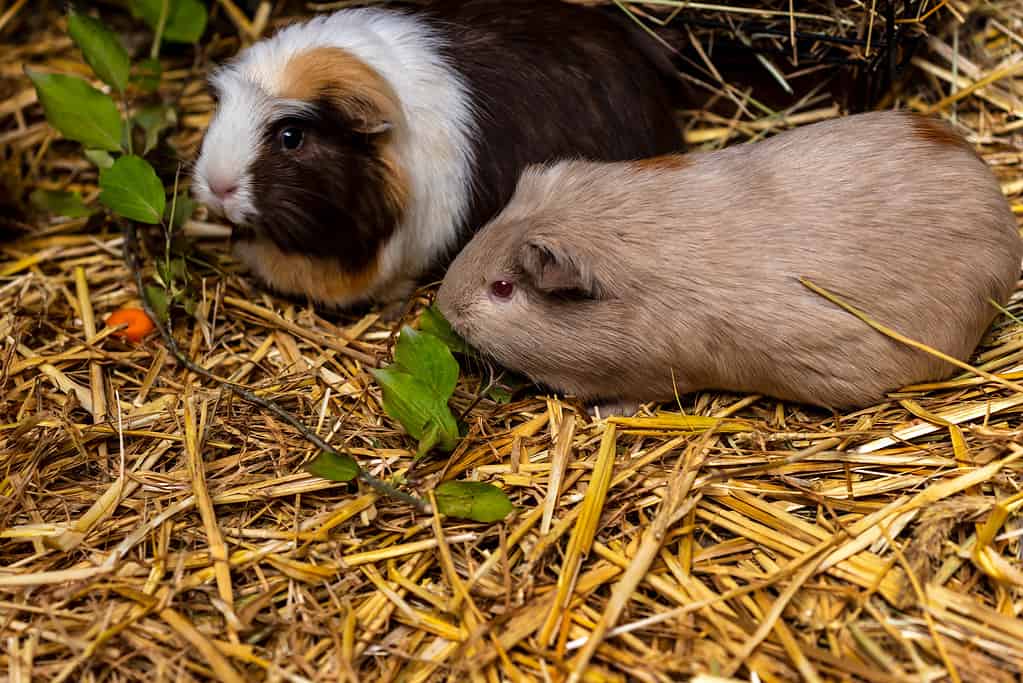
Guinea pigs make fun and low-maintenance pets.
©Vronja_Photon/iStock via Getty Images
These adorable little pets eat a lot of fruit. Guinea pigs do best with a diet balanced between commercial guinea pig pellet food, grass or hay, and fresh vegetables and fruits. Their favorites include oranges, apples, kiwi, and strawberries. These are also a good addition to their diet because they are rich in Vitamin C, a critical nutrient that guinea pigs only get through their diet. Fruit is higher in sugar than vegetables, so make sure to keep it as a once-per-day treat rather than the majority of their diet.
#9 Aldabra Giant Tortoise
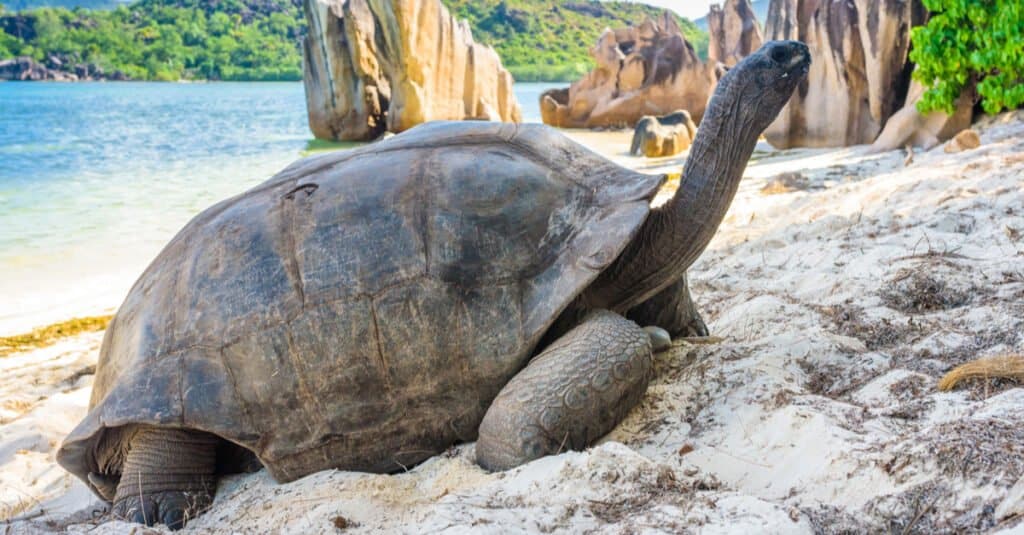
Aldabra tortoises have long necks and large shells that protect them.
©Jan Bures/Shutterstock.com
These large tortoises are some of the biggest land tortoises in the world. They can get up to 550 pounds and live for more than 250 years. Aldabra tortoises live on Aldabra Island in the Indian Ocean. They eat in the early morning, foraging for food around the atoll. They have to spend a lot of time looking for food to sustain their large size. Some of their favorites include grass and herbs, which are plentiful in large fields on Aldabra Island. For this reason, these areas have become known as “turtle turf” because turtles will gather there to eat. They also eat berries, fruit, leaves, and nuts in the same areas.
#10 Spectacled Bear

Andean bear, also known as the spectacled bear, is the closest living relative of Arctotherium angustidens, who lived in South America during the Pleistocene period.
©Andrei Preda/Shutterstock.com
Also called Andean bears because they live near the Andes mountains, these animals have an unexpected diet. While other bears eat fish, small mammals, and other sources of meat, spectacled bears favor fruit and grasses, especially berries and some flowers. They eat small rodents and birds when they find them in their environment. Spectacled bears can climb trees, which they do to find food as well as seek shelter and distance from potential predators. Unlike other bears, spectacled bears do not hibernate and are active all through the year. They can find plenty of food in all seasons, which is likely why they are able to survive without going into a dormant state in the winter months.
#11 Great Hornbill
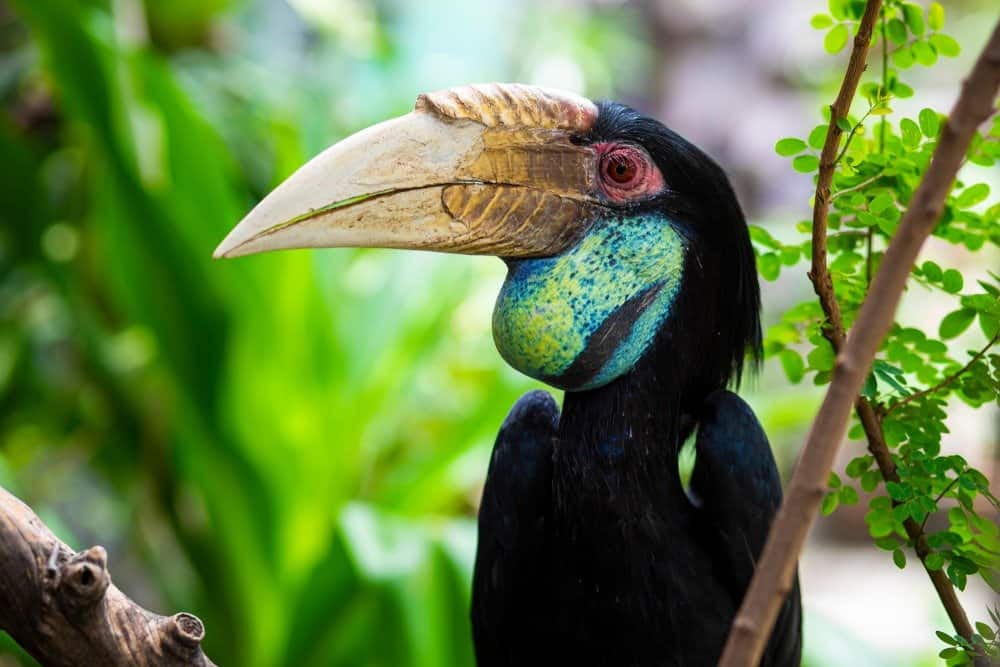
Hornbills have curved beaks that help them get food out of trees.
©ONGUSHI/Shutterstock.com
Hornbills are omnivores but around 70% of their diet consists of fruit. Figs are some of their favorite foods and they will even get aggressive with other animals who try to take figs from their favorite trees. They are named for their large, curved bills which they use to get food. They have prominent horns on the top of their bills. Some species spend the majority of their time in trees while others are exclusively ground birds. Hornbills get most of the water that they need from their food, which is one reason why they eat so much fruit.
The largest hornbills can weigh as much as 13 pounds or more. Smaller species weigh just a fraction of that. Many eat up to 1/3 of their body weight each day in fruit. Their bodies are very good at breaking down fruit and processing the water in their food. When they aren’t eating fruit, these birds also eat insects and even some small mammals. They have sharp edges on their bills that they use to tear apart food.
#12 Quokka
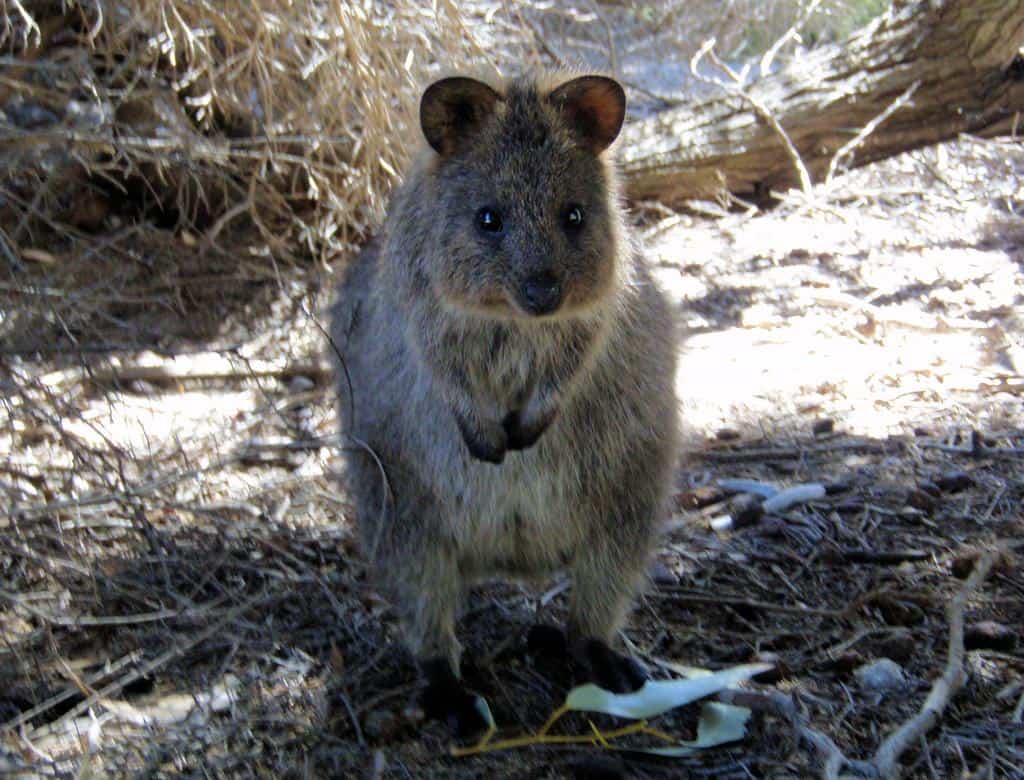
Quokkas live on islands off the coast of Australia.
©Ken and Nyetta / Creative Commons
This adorable mammal is a marsupial that lives in Australia. They are plentiful on Rottnest Island and Bald Island. They have short, bristly fur, round ears, and a snout that gives them an adorable appearance. But don’t be fooled, these are still wild animals and should be given their space. Quokkas aren’t aggressive but will fight over territory, especially when they need to get shelter from the hot Australian sun. They like to live in places with plenty of plants, which makes sense because they are herbivores. They like to eat grasses, fruit, and berries. Quokkas feed primarily at night and rest in the shade during the day.
#13 Fruit Bat
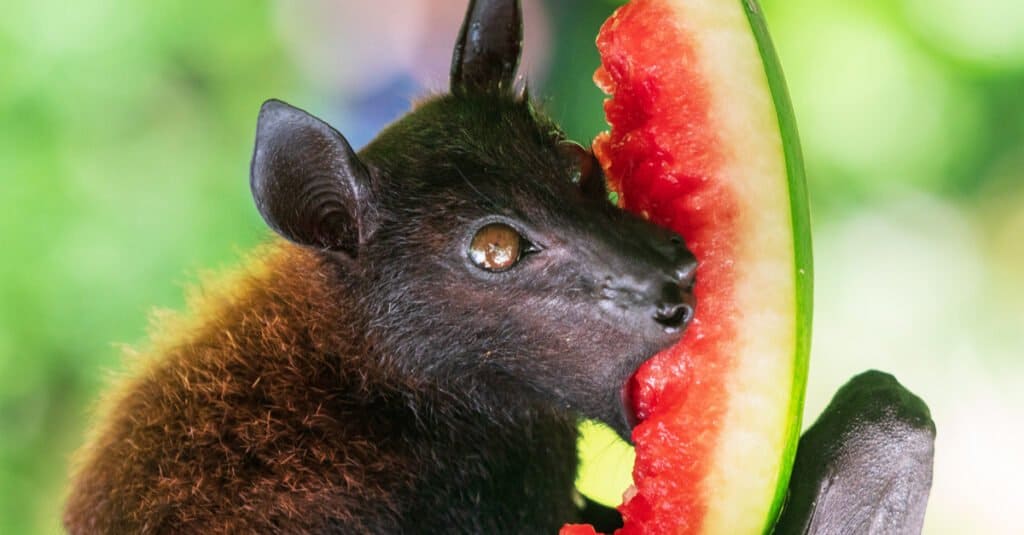
Fruit bats are actually mammals that can fly.
©Anton Watman/Shutterstock.com
While they do eat fruit, the name of fruit bat might be a bit of a misnomer when it comes to these animals. They actually eat the juice of the fruits and spit out the pulp. They also eat nectar and pollen. Fruit bats also eat leaves and sap, putting it through a similar process to extract the juice. This actually has a major impact on their environment. Fruit bats disperse seeds and nuts throughout the area as a byproduct of their feeding habits. There are numerous species included under the fruit bat name, which broadly applies to any bat that consumes fruit. The scientific name Pteropodidae applies to this family of bats.
#14 Three-Toed Sloth
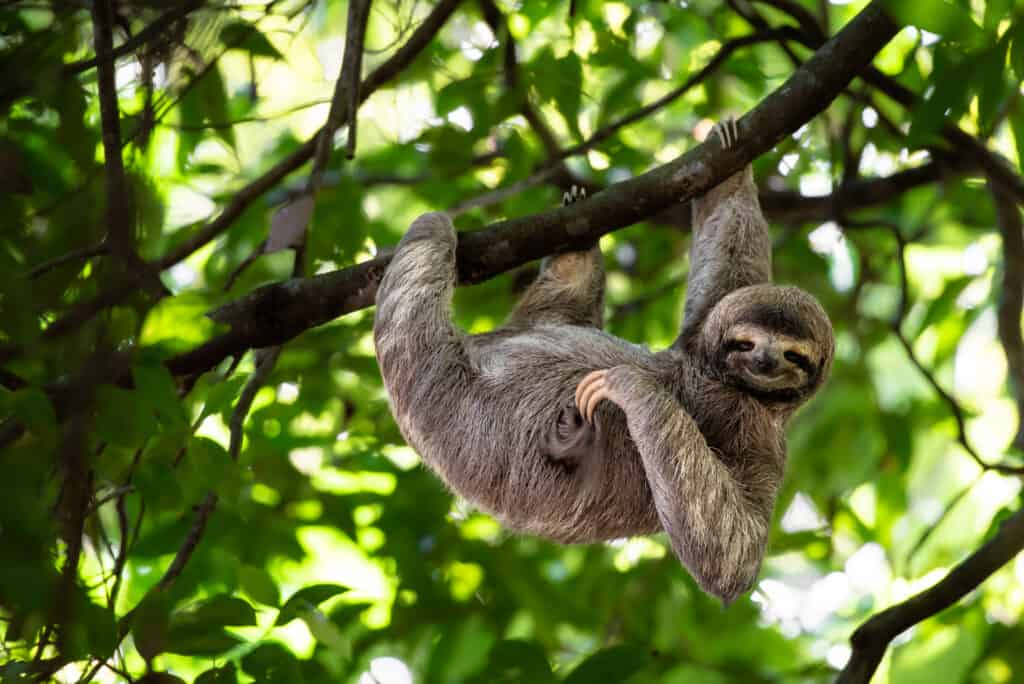
Sloths spend most of their days sleeping or foraging for food.
©Lukas Kovarik/Shutterstock.com
These animals are known for being super slow, which is one reason why three-toed sloths don’t need to eat a lot of food. They have slow metabolism rates so it takes them a long time to process and use the energy that they get from their food. They are herbivores and eat leaves, fruit, and twigs. Sloths can’t break down their food with sharp teeth. Instead, they grind it down until it is pulpy and they can digest it. Fortunately for sloths, they don’t have to worry about getting a lot of food because it is plentiful in their environment. They spend their limited waking hours foraging for food but often sleep up to 20 hours each day.
#15 Malayan Tapir
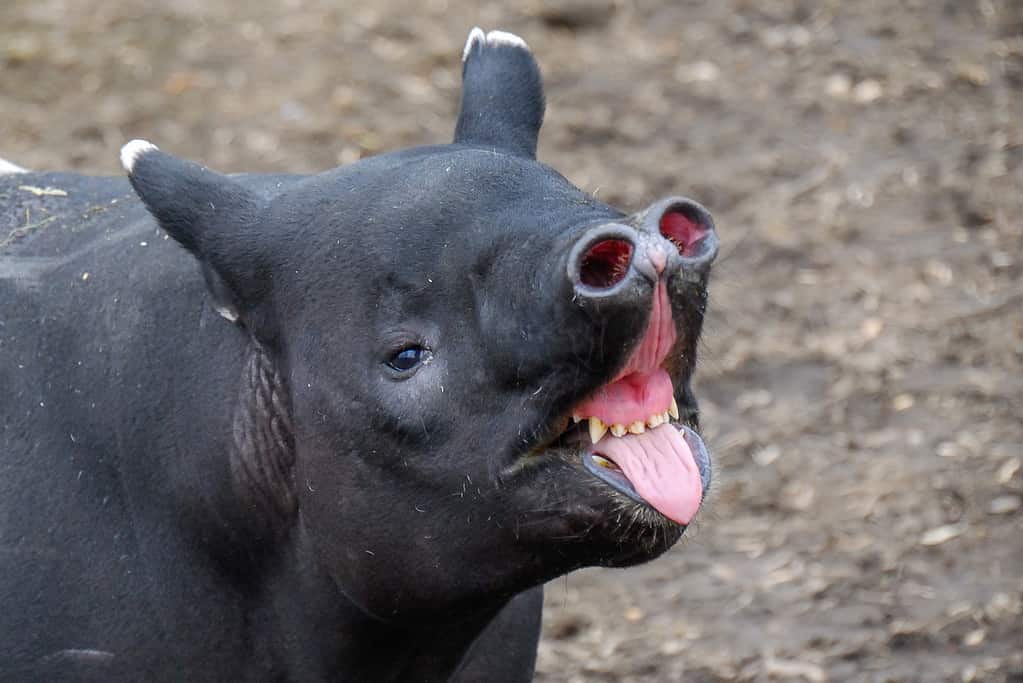
Malayan tapirs are the largest species of tapir.
©Marek Rybar/Shutterstock.com
These unique animals are related to horses and rhinos. So it’s not surprising that they are also herbivores and eat a diet made up entirely of plants. They can’t climb so they eat mostly fruits on low shrubs, twigs and leaves from ground plants and low shrubs, and aquatic plants. They can use their long noses to forage and grab at some food sources that other animals may not be able to reach from the ground. In zoos, tapirs enjoy a diet similar to what they’d find in the wild. They also eat apples, bananas, carrots, and sweet potatoes. They tend to prefer softer fruits and plants.
In addition to Malayan tapirs, there are three or four other species of tapirs, depending on which classification guidelines you include. All tapirs have similar diets in the wild. Destruction of their habitat and hunting, especially for their skin, is a threat in some areas.
Summary of Frugivores
| Number | Animal |
| 1 | African Bush Elephant |
| 2 | Mourning Dove |
| 3 | Spix’s Macaw |
| 4 | Spider Monkey |
| 5 | Black Rhinoceros |
| 6 | Baltimore Oriole |
| 7 | Bornean Orangutan |
| 8 | Guinea Pig |
| 9 | Aldabra Giant Tortoise |
| 10 | Spectacled Bear |
| 11 | Great Hornbill |
| 12 | Quokka |
| 13 | Fruit Bat |
| 14 | Three-Toed Sloth |
| 15 | Malayan Tapir |
The photo featured at the top of this post is © Natalia Golovina/Shutterstock.com
Thank you for reading! Have some feedback for us? Contact the AZ Animals editorial team.






